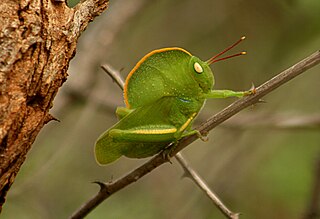
Acrididae, commonly called short-horned grasshoppers, are the predominant family of grasshoppers, comprising some 10,000 of the 11,000 species of the entire suborder Caelifera. The Acrididae are best known because all locusts are of the Acrididae. The subfamily Oedipodinae is sometimes classified as a distinct family Oedipodidae in the superfamily Acridoidea. Acrididae grasshoppers are characterized by relatively short and stout antennae, and tympana on the side of the first abdominal segment.

Bandwings, or band-winged grasshoppers, are the subfamily Oedipodinae of grasshoppers classified under the family Acrididae. They have a worldwide distribution and were originally elevated to full family status as the Oedipodidae. Many species primarily inhabit xeric weedy fields, and some are considered to be important locusts:

Tetrigidae is an ancient family in the order Orthoptera, which also includes similar families such as crickets, grasshoppers, and their allies. Species within the Tetrigidae are variously called groundhoppers, pygmy grasshoppers, pygmy devils or "grouse locusts".

Isophya is a genus of bush crickets, in the tribe Barbitistini, found from mainland Europe to western Asia.

Oedipoda is the type genus of grasshoppers, in the subfamily Oedipodinae, mostly from the Palaearctic realm. The type species is the European "blue-winged grasshopper", Oedipoda caerulescens.

Dociostaurus is a genus of grasshoppers in the family Acrididae, subfamily Gomphocerinae and typical of the tribe Dociostaurini. Species are found in Africa, southern Europe and Asia, and includes the economically important Moroccan locust.
Scelimeninae is a subfamily of ground hoppers belonging to the Tetrigidae family of Orthopterans.

Heteropternis is a genus of grasshoppers in the family Acrididae, subfamily Oedipodinae, and tribe Epacromiini. The recorded distribution of species in Heteropternis is from Africa and India through to Japan, Malesia, and Papua New Guinea.

Truxalis is a genus of grasshoppers in the family Acrididae, subfamily Acridinae and tribe Truxalini. Species can be found in: Africa, the Iberian peninsula, Asia minor through to Indo-China.
Gelastorhinus is a genus of grasshoppers in the subfamily Gomphocerinae. Species have been recorded from tropical Africa and Asia.
Anabropsis is a genus of king crickets in the tribe Anabropsini. They are found tropical areas of the Americas, Africa and Asia.

Truljalia is a genus of crickets in the subfamily Podoscirtinae and tribe Podoscirtini. Species have been recorded in: India, southern China, Korea, Japan, Indo-China and west Malesia.

Teratodinae is a subfamily of grasshoppers in the family Acrididae. There are about 8 genera and more than 20 described species, found in East Africa and South-West Asia.
Iranotmethis is a genus of grasshopers in the subfamily Thrinchinae, with species found in Iran.

Thrinchinae is a subfamily of grasshoppers, with genus found in Africa, Europe and Asia.
Podismopsis is a genus of grasshoppers in the subfamily Gomphocerinae and tribe Chrysochraontini, erected by Zubovski in 1900. Species have been recorded from central Europe through to temperate east Asia, including Japan.
Mesasippus is a genus of grasshoppers in the tribe Gomphocerini, erected by Yu S, Tarbinsky in 1931. Species have been recorded from eastern Europe through to central China.
Glyphotmethis is a genus of mostly European grasshoppers belonging to the family Pamphagidae, erected by Bey-Bienko in 1951. Belonging to the tribe Thrinchini, species can be found in south-eastern Europe through to Turkey.
Gryllopsis is a genus of crickets in the tribe Modicogryllini, erected by Lucien Chopard in 1928. Species appear to be widely distributed : mostly in tropical Africa and Asia, with Gryllopsis caspicus the only European record.










